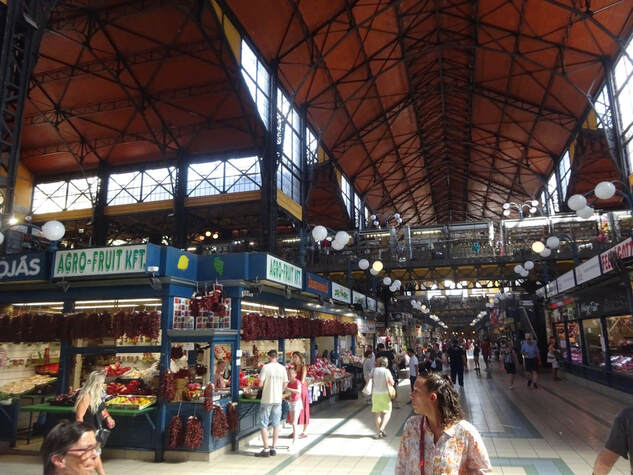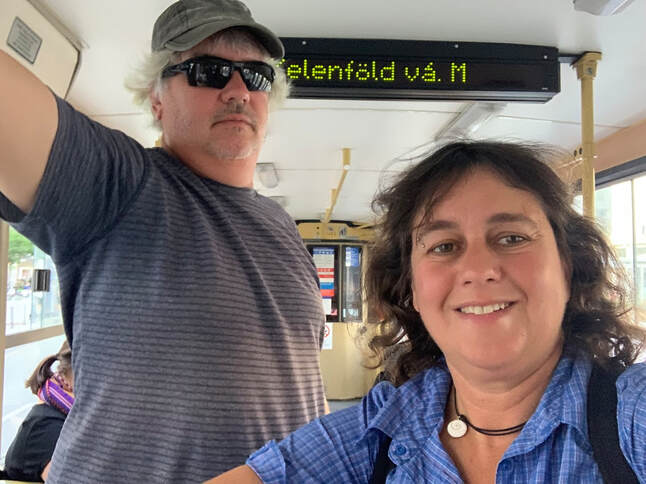Today we start with finishing our Pest town center tour that was rain shortened 3 days ago.
Here's a typical cafe with outside fair-weather seating.
Here's a typical cafe with outside fair-weather seating.
Looking in the direction of Elisabeth Bridge on the Danube.
A closer look at the bridge.
Inner-City Church of the Franciscans
Nicely restored four-story building.
Szent György Nagyvértanú, Serbian Orthodox temple, completed 1752.
The Great Market Hall is the largest and oldest indoor market in Budapest with its opening ceremony on February 15, 1897. During World War II the market was significantly damaged and remained in deteriorating condition in the following decades. In 1991 a thorough renovation was undertaken to bring it back to its original splendor re-opening in 1997 to much excitement.
We had no needs for any of this market food, but it was well-stocked and interesting to check out.
An older street tram train.
Time for a brewery break.
A 4-taster - pretty good stuff.
Now aboard the tram, and heading for the other side of the Danube, to the Buda part of Buda-Pest.
We get a better view than we had earlier of the Chain Bridge from the other side.
A early rendering of Budapest, with the beginnings of Pest in the foreground, and the heights of Buda across the river.
Another historic view of Buda. "Buda was the historic capital of the Kingdom of Hungary and since 1873 has been the western part of the Hungarian capital Budapest, on the west bank of the Danube. Buda comprises a third of Budapest's total territory and is mostly wooded. Landmarks include Buda Castle, the Citadella, and the president of Hungary's residence, Sándor Palace. The Buda fortress and palace were built by King Béla IV of Hungary in 1247, and were the nucleus around which the town of Buda was built and became in 1361 the capital of Hungary."
A view of Parliament in the distance, back across the Danube, in Pest.
A panorama of Pest...
The Danube terrace of Buda Castle with Eugene of Savoy's monument.
The Chain Bridge and Parliament together.
River traffic plying the Danube.
"Liberty Statue was first erected in 1947 in remembrance of the Soviet liberation of Hungary during World War II, which ended the occupation by Nazi Germany. Its location upon Gellért Hill makes it a prominent feature of Budapest's cityscape. The 14 m tall bronze statue stands atop a 26 m pedestal and holds a palm leaf. "
There are so many good views of the city to be had from the heights of Buda.
Matthias Fountain (below left)The spectacular fountain decorates the western forecourt of the palace. It shows a group of hunters led by King Matthias Corvinus together with hounds, a killed deer, Galeotto Marzio with a hawk and Szép Ilonka with a doe. This group of people stands between fallen rocks with water running down into a basin. The damaged sculpture was restored after the war. Nowadays it is probably the most photographed object in the palace.
Buda Castle with twilight coming on.
The Sándor Palace (below left) located beside the Buda Castle complex in the ancient Castle District, it has served as the official residence and workspace of the President of Hungary since 2003.
The Church of the Assumption of the Buda Castle, more commonly known as the Matthias Church, more rarely the Coronation Church of Buda, is a Roman Catholic church located in the Holy Trinity Square, in front of the Fisherman's Bastion at the heart of Buda's Castle District. According to church tradition, it was originally built in Romanesque style in 1015, although few references exist. The current building was constructed in the florid late Gothic style in the second half of the 14th century and was extensively restored in the late 19th century. Two Kings of Hungary were crowned within its walls: Franz Joseph I of Hungary and Elisabeth, and Charles IV of Hungary and Zita of Bourbon-Parma.
Statue of Stephen I of Hungary by Alajos Stróbl.
Parliament all dressed up in golden lights.
The golden lights reflect off low hanging clouds.
The Halászbástya or Fisherman's Bastion is one of the most important tourist attractions due to the unique panorama of Budapest from the Neo-Romanesque lookout terraces. Its seven high-pitched stone towers symbolize the seven chieftains of the Hungarians who founded Hungary in 895.
The original walls were built in the 1700s, forming part of the walls of a castle. Several historians say that in the Middle Ages this part of the castle walls was protected by the guild of fishermen (halász), who lived under the walls in the so-called Fishtown or Watertown. The current structure was built between 1895 and 1902, in Neo-Romanesque style, on the base of a stretch of the Buda Castle walls.
The original walls were built in the 1700s, forming part of the walls of a castle. Several historians say that in the Middle Ages this part of the castle walls was protected by the guild of fishermen (halász), who lived under the walls in the so-called Fishtown or Watertown. The current structure was built between 1895 and 1902, in Neo-Romanesque style, on the base of a stretch of the Buda Castle walls.
The Church of Mary Magdalene of Buda is one of the oldest churches of the Várkerület District (Buda Castle District). Dedicated to Jesus' follower, Mary Magdalene, it was built between the 13th and 15th centuries in Gothic style. Only the tower of the church remains, with the rest in ruin. The siege of Budapest's allied bombing caused much destruction, while more havoc finished the job with Communist meddling during attempted reconstruction.
For centuries, the Church of Mary Magdalene was the forum of the population of Buda District. Then, the church became the site of the coronation of Francis II, Holy Roman Emperor as Hungarian king, and finally as the central church of the garrison of the Buda Castle.
Mária Magdolna-templom
For centuries, the Church of Mary Magdalene was the forum of the population of Buda District. Then, the church became the site of the coronation of Francis II, Holy Roman Emperor as Hungarian king, and finally as the central church of the garrison of the Buda Castle.
Mária Magdolna-templom




















































 RSS Feed
RSS Feed
